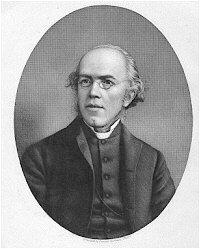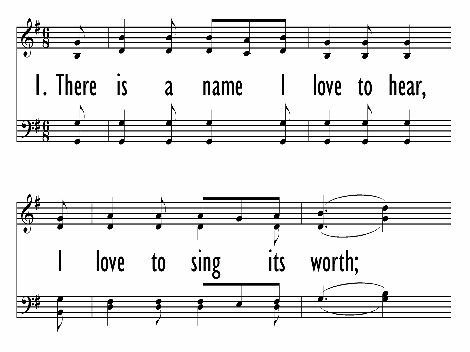- |
User Links
O How I Love Jesus

There is a name I love to hear, I love to sing its worth
Author: Frederick WhitfieldTune: O HOW I LOVE JESUS
Songs of Response
Published in 590 hymnals
Printable scores: PDFPlayable presentation: Lyrics only, lyrics + musicAudio files: MIDI, Recording
Representative Text
1 There is a name I love to hear,
I love to sing its worth;
it sounds like music in my ear,
the sweetest name on earth.
Refrain:
O how I love Jesus,
O how I love Jesus,
O how I love Jesus,
because he first loved me!
2 It tells me of a Savior's love,
who died to set me free;
it tells me of his precious blood,
the sinner's perfect plea. [Refrain]
3 It tells of one whose loving heart
can feel my deepest woe;
who in each sorrow bears a part
that none can bear below. [Refrain]
United Methodist Hymnal, 1989
Author: Frederick Whitfield
 Whitfield, Frederick, B.A., son of H. Whitfield, was born at Threapwood, Shropshire, Jan. 7, 1829, and educated at Trinity College, Dublin, where he took his B.A. in 1859. On taking Holy Orders, he was successively curate of Otley, vicar of Kirby-Ravensworth, senior curate of Greenwich, and Vicar of Stanza John's, Bexley. In 1875 he was preferred to St. Mary's, Hastings. Mr. Whitfield's works in prose and verse number upwards of thirty, including Spiritual unfolding from the Word of Life; Voices from the Valley Testifying of Jesus; The Word Unveiled; Gleanings from Scripture, &c. Several of his hymns appeared in his Sacred Poems and Prose, 1861, 2nd Series, 1864; The Casket, and Quiet Hours in the Sanctuary. The hymn by which he is most wid… Go to person page >
Whitfield, Frederick, B.A., son of H. Whitfield, was born at Threapwood, Shropshire, Jan. 7, 1829, and educated at Trinity College, Dublin, where he took his B.A. in 1859. On taking Holy Orders, he was successively curate of Otley, vicar of Kirby-Ravensworth, senior curate of Greenwich, and Vicar of Stanza John's, Bexley. In 1875 he was preferred to St. Mary's, Hastings. Mr. Whitfield's works in prose and verse number upwards of thirty, including Spiritual unfolding from the Word of Life; Voices from the Valley Testifying of Jesus; The Word Unveiled; Gleanings from Scripture, &c. Several of his hymns appeared in his Sacred Poems and Prose, 1861, 2nd Series, 1864; The Casket, and Quiet Hours in the Sanctuary. The hymn by which he is most wid… Go to person page >Text Information
Related Texts
| First Line: | There is a name I love to hear, I love to sing its worth |
| Title: | O How I Love Jesus |
| Author: | Frederick Whitfield |
| Meter: | 8.6.8.6 with refrain |
| Language: | English |
| Refrain First Line: | O how I love Jesus |
| Notes: | Spanish translation: See "Es Cristo quien por mí murió"; Swahili translation: See "Yesu ni jina nipendalo". |
| Copyright: | Public Domain |
| Liturgical Use: | Songs of Response |
Chinese
English
- A Collection of Hymns and Sacred Songs: suited to both private and public devotions, and especially adapted to the wants and uses of the brethren of the Old German Baptist Church #53
- A Collection of Hymns for Public and Private Devotion #d251
- A Collection of Psalms, Hymns and Spiritual Songs; suited to the various kinds of Christian worship; and especially designed for and adapted to the Fraternity of the Brethren... #67
- A Collection of Spiritual Hymns: adapted to the Various Kinds of Christian Worship, and especially designed for the use of the Brethren in Christ. 2nd ed. #33
- A Messenger for Jesus #d294
- A Selection of Hymns for the Use of Church of England Sunday Schools, Bible Classes ... New ed. #d276
- A. M. E. C. Hymnal #86
- A.M.E. Hymnal: with responsive scripture readings...(The Richard Allen A.M.E. Hymnal) #d381
- Abiding Songs #d130
- Action: a collection of gospel songs and choruses compiled especially for boys and girls (Vol. 1) #64 10 shown out of 429
Korean
For Leaders
Text:
The stanzas of this hymn were written in 1855 by Frederick Whitfield, an English clergyman. The text was first printed in hymn sheets and leaflets, and was published in 1861 by Whitfield in his Sacred Poems and Prose in London. It was first published in the United States no later than 1864.
The refrain is anonymous, and was paired with many other hymns in the second half of the nineteenth century, including “Amazing Grace” by John Newton and “Alas! and Did My Savior Bleed” by Isaac Watts. Its earliest known appearance in publication was during the 1860s.
Of the nine original stanzas Whitfield wrote, only four are in common use today; they are the first, second, fourth, and fifth. A few hymnals omit the third of these (“It tells me what my Father has”). The stanzas' theme is the many pleasant associations and promises that the name of Jesus has for a devout Christian believer.
Tune:
The origins of the tune O HOW I LOVE JESUS lie in the camp-meetings of nineteenth-century America. The tunes of the stanzas and the refrain may have originated separately. Though they blend well together, the stanza tune begins with an upbeat and has a steady long-short rhythm, while the refrain tune emphasizes the main beats of the measure. The whole tune has a gentle, almost dance-like quality and is easy to sing.
When/Why/How:
This hymn is good for general use at any time of year as a devotional song. Two Scripture passages that the hymn could be sung with are I John 4:19, which the refrain quotes, and Hebrews 4:15-16, at which the final stanza hints. Another possibility is the broad theme of the love of Jesus, perhaps in medley with other hymns on the same theme, such as in the extended choral medley “More Love to Thee” or the piano medley in “Prayludes for Summer.”
Tiffany Shomsky, Hymnary.org
Timeline
Arrangements
Media
Small Church Music #223
- PDF Score (PDF)
Timeless Truths #470
- Oh_How_I_Love_Jesus.pdf (PDF)
The United Methodist Hymnal #170
- Audio recording from African American Heritage Hymnal #291
- MIDI file from Baptist Hymnal 1991 #217
- Audio recording from Baptist Hymnal 1991 #217
- MIDI file from Baptist Hymnal 1991 #217
- Audio recording from Baptist Hymnal 2008 #560
- Audio recording from The Celebration Hymnal: songs and hymns for worship #92
- Audio recording from Celebrating Grace Hymnal #601
- MIDI file from The Cyber Hymnal #4969
- MIDI file from Gloria Deo: a Collection of Hymns and Tunes for Public Worship in all Departments of the Church #230
- MIDI file from Hymns of Consecration and Faith #280
- Audio recording from Lift Up Your Hearts: psalms, hymns, and spiritual songs #676
- Audio recording from Lift Up Your Hearts: psalms, hymns, and spiritual songs #676
- Audio recording from Lift Up Your Hearts: psalms, hymns, and spiritual songs #676
- Audio recording from Small Church Music #223
- Audio recording from Small Church Music #223
- MIDI file from Timeless Truths #470
- Audio recording from The Worshiping Church #509
- MIDI file from The United Methodist Hymnal #170
- Audio recording from The United Methodist Hymnal #170
- MIDI file from Worship and Rejoice #109


 My Starred Hymns
My Starred Hymns







